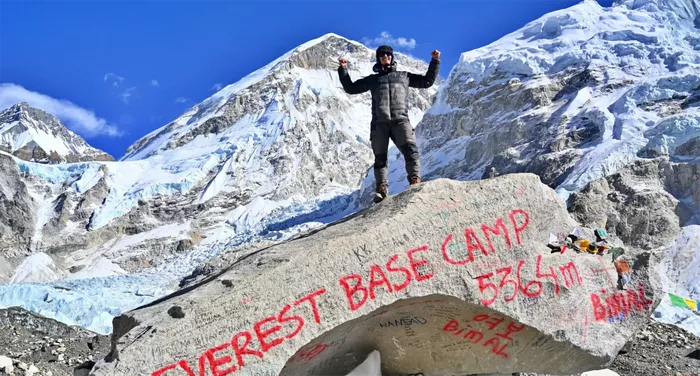Nestled in the majestic Himalayas, the Everest Base Camp trek stands as an iconic pilgrimage for adventurers seeking to conquer the world’s highest peak. With its awe-inspiring landscapes, rich cultural tapestry, and unparalleled sense of achievement, this trek promises an unforgettable experience. However, with several route options, varying tour operators, and essential considerations, planning the best-ever base camp trek requires careful deliberation and preparation.
Everest Base Camp Trek Options:
1. Comparison of Popular Routes:
- Classic EBC Trek: The traditional route starts from Lukla, passing through Namche Bazaar, Tengboche, and Gorak Shep before reaching Everest Base Camp. It offers stunning views of Everest and allows trekkers to immerse themselves in the Sherpa culture.
- Jiri to EBC: For those seeking a longer and more challenging journey, the Jiri route involves a scenic bus ride to Jiri, followed by a trek through the picturesque landscapes of the Solu Khumbu region before joining the classic route at Lukla.
- Gokyo Lakes: This alternative route diverges from the classic trail at Namche Bazaar, leading trekkers to the emerald Gokyo Lakes, offering breathtaking vistas of Everest, Cho Oyu, and other Himalayan peaks.
- Three Passes Trek: Reserved for the more experienced and adventurous trekkers, this route traverses three high passes—Renjo La, Cho La, and Kongma La—providing unparalleled views and an adrenaline-pumping challenge.
2. Overview of Different Tour Operators:
Reputable Companies: Renowned tour operators such as Himalayan Glacier, Adventure Mountain Explore Treks, and Exodus Travels offer a range of trekking packages catering to different budgets and preferences. From group expeditions to private guided tours, these operators ensure a safe and memorable experience.
3. Pros and Cons of Each Option:
Each route offers its unique set of advantages and challenges:
- Difficulty: The classic EBC trek is relatively moderate in difficulty, whereas the Three Passes Trek demands a higher level of fitness and experience due to its strenuous nature.
- Cost: The cost varies depending on factors such as route, duration, and services included. The Jiri route is generally more economical, while the Gokyo Lakes and Three Passes treks may require a higher budget due to additional permits and logistics.
- Duration: The classic EBC trek typically takes around 12-14 days, while longer routes like Jiri to EBC and Three Passes Trek may extend up to 20-25 days.
- Scenery: Each route offers spectacular vistas of the Himalayas, with highlights including Everest, Lhotse, Nuptse, and Ama Dablam. The Gokyo Lakes route stands out for its tranquil lakes and panoramic views, while the Three Passes Trek provides unparalleled high-altitude adventure.
- Acclimatization Profiles: Adequate acclimatization is crucial to mitigate the risk of altitude sickness. All routes incorporate rest days for acclimatization, but the Three Passes Trek presents greater challenges due to its higher altitude and demanding terrain.
Essential Trek Information:
1. Physical Fitness Requirements and Training Tips:
Preparing for the Everest Base Camp trek requires a combination of cardiovascular endurance, strength, and mental resilience. Engaging in regular aerobic exercises such as hiking, running, and cycling, coupled with strength training and altitude simulation, can help improve fitness levels and prepare the body for the rigors of high-altitude trekking.
2. Packing List and Gear Recommendations:
Packing wisely is essential to ensure comfort and safety throughout the trek. Key items include sturdy hiking boots, moisture-wicking clothing, a warm sleeping bag, a down jacket, sunglasses, a hat, sunscreen, and a first-aid kit. Additionally, trekking poles, a headlamp, and a portable water purification system are invaluable accessories.
3. Altitude Sickness Awareness and Prevention:
Altitude sickness, or acute mountain sickness (AMS), is a serious concern when trekking at high elevations. Symptoms include headache, nausea, dizziness, and fatigue. To prevent AMS, it is essential to ascend gradually, stay hydrated, and listen to your body. Acclimatization days allow trekkers to adapt to the altitude, while medications such as acetazolamide can help alleviate symptoms.
4. Best Time to Trek:
The optimal trekking seasons are spring (March to May) and autumn (September to November), characterized by stable weather conditions, clear skies, and moderate temperatures. Spring offers vibrant rhododendron blooms, while autumn provides crisp, clear views of the Himalayan peaks. Winter treks are possible but entail colder temperatures and potential snowfall, while the monsoon season (June to August) brings heavy rainfall and limited visibility.
5. Permits and Regulations:
Trekking in the Everest region requires obtaining permits from the Nepal Tourism Board and the Sagarmatha National Park authorities. The Sagarmatha National Park Entry Permit and the TIMS (Trekkers’ Information Management System) Card are mandatory for all trekkers. Additionally, special permits are required for certain routes, such as the Three Passes Trek and the Gokyo Lakes.
Additional Considerations:
1. Cultural Sensitivity and Responsible Tourism:
Respecting local customs, traditions, and environmental conservation practices is essential for sustainable and responsible tourism. Trekkers are encouraged to engage with the local communities, support local businesses, and minimize their ecological footprint by practicing Leave No Trace principles.
2. Travel Insurance and Safety Precautions:
Obtaining comprehensive travel insurance that covers medical emergencies, evacuation services, and trip cancellations is imperative for trekking in remote mountainous regions. Additionally, adhering to safety guidelines, staying hydrated, and following the guidance of experienced guides can mitigate risks and ensure a safe and enjoyable trekking experience.
3. Budgeting and Cost Estimation:
Budgeting for the Everest Base Camp trek involves considering expenses such as permits, accommodation, meals, guide and porter fees, gear rental or purchase, and incidental costs. While the overall cost may vary depending on factors such as route, duration, and amenities, budgeting transparently and accounting for potential unforeseen expenses is essential for financial planning.
Conclusion
In conclusion, embarking on the best-ever base camp trek is a dream within reach for adventurers willing to embrace the challenge, beauty, and cultural richness of the Himalayas. With careful planning, preparation, and a spirit of adventure, the journey to Everest Base Camp promises to be an unforgettable odyssey of discovery, accomplishment, and awe-inspiring moments that will be cherished for a lifetime.

